- Home
- About
- Training Courses
- ASME Courses
- API Courses
- API 510 Pressure Vessel
- API 570 Process Pipework
- API 653 Aboveground Storage Tank
- API 936 Refractory Personnel
- API 580 RBI Online
- API 580 RBI Classroom *New*
- API 571 Corrosion & Materials Online
- API 571 Corrosion & Materials Classroom *New*
- API 577 Welding Inspection & Metallurgy Online
- API 510 CPD Training
- API 570 CPD Training
- API 1169 Pipeline Construction
- API SIFE Source Inspector Fixed Equipment
- API SIRE Source Inspector Rotating Equipment
- E-Learning
- Technical Courses
- API CPD Recertification
- Training Courses
- Technical Hub
- Virtual Training
- FAQs
- Contact
- Online Training Portal
- Shop
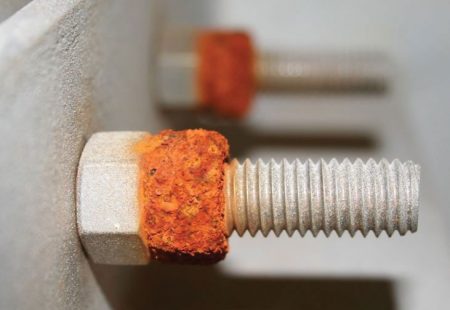
- In: Training | On: Jun 29, 2021
Salt is bad for your health! – Corrosion basics
Corrosion Basics Part 1
Salt is bad for your health! – Corrosion basics
Definition:
Corrosion is the degradation of a metal by its environment–it literally means to “eat-away”. Most metals do not naturally occur as a pure metal. In their natural state, they exist in the form of oxides. These metal oxides (or other metal compounds) must be refined to create the pure metals or alloys which become useful structural materials that can be used to build things.
Pure metals and alloys have a much higher energy state and there is a natural tendency to return to their lower energy state. Corrosion is the process nature uses to return metals to their original state. The rate of corrosion depends upon the environment and the type of material. It can be very rapid in a highly corrosive environment or much longer in a slightly corrosive environment.
Corrosion, whether in the atmosphere, underwater, or underground, is caused by the flow of electricity from one metal to another metal, or from one part of the surface of a piece of metal to another part of the same metal where conditions permit the flow of electricity. For this to occur there must be a moist conductor or electrolyte present for the flow of energy to take place.
Different types:
There are many types of corrosion that can affect metals. They include:
general, galvanic, pitting, crevice, erosion, stress, biological, and intergranular.
The most likely are:
- galvanic/electrochemical
- microbiological
- pitting and crevice
- intergranular
Galvanic/Electrochemical:
The diagram below illustrates a cell showing the corrosion process in its simplest form. This cell includes the following essential components.
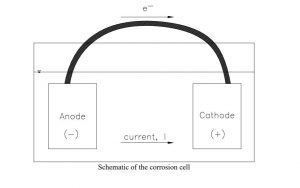
- A metal anode
- A metal cathode
- A metallic conductor between the anode and the cathode
- An electrolyte (water) in contact with the anode and cathode, but not necessarily of the same composition at the two locations.
The components are arranged to form a closed electrical path or circuit.
Suppose that the anode is iron, the cathode is copper, and the electrolyte is water containing mineral salts. The anode is negatively charged and the cathode is positively charged. This difference in charge (voltage) provides potential voltage, which is the driving force for current to flow in the cell.
Since the iron in the test cell is negatively charged, and the copper is positively charged, there is a potential voltage difference that causes a flow of electricity. The anode will give off iron ions in the form of rust (corrosion), while hydrogen gas would be produced at the cathode and no destruction will occur. Corrosion occurs only on the anode. The rate of corrosion in the cell will be dependent upon the relative sizes of the anode and cathode and the potential difference between the anode and the cathode.
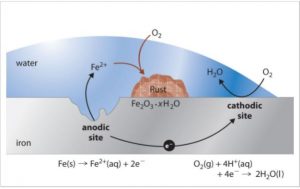
If, for instance, the anode was very small and the cathode was large, the rate of corrosion would be very rapid. The opposite would be true if there was a very large anode compared to the cathode. If the anode was nickel and the cathode brass, there will be very little corrosion, because the voltage potential difference will be slight.
Galvanic corrosion occurs when dissimilar metals are used.
Galvanic corrosion (also called ‘dissimilar metal corrosion’) occurs when a metal or alloy is electrically coupled to another metal or conducting non-metal in the same electrolyte. When dissimilar metals are electrically coupled (i.e. galvanic coupling), corrosion of the less noble metal increases and the surface becomes anodic, while corrosion of the more noble metal decreases and the surface becomes cathodic. The driving force for corrosion or galvanic current flow is the potential developed between the dissimilar metals. When the materials have a large difference in voltage charge they are more likely to corrode. For instance, if aluminium was the anode and silver was the cathode, the aluminium would corrode very rapidly because they are dissimilar metals. Of course, to corrode there must be an electrolyte present—water, moist air, etc. Naturally the closer together the metals or alloys are in the galvanic series, the less aggressive the corrosion.
Another important factor in galvanic corrosion is the area effect or the ratio of cathodic to the anodic area. The larger the cathode compared with the anode, the greater the galvanic current and therefore the more aggressive the corrosion. From the standpoint of practical corrosion resistance, the least favourable ratio is a very large cathode connected to a very small anode.
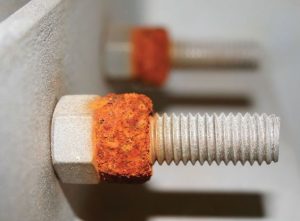
Materials are listed in the galvanic serious in order of how noble the material is. The further apart in the galvanic series the more aggressive the corrosion.
Galvanic Series of Metals:
| CORRODED END (anodic, or least noble) |
| Magnesium, Magnesium alloys |
| Zinc |
| Cadmium |
| Aluminium 2017 |
| Steel or iron, Cast iron |
| Chromium-iron (active) |
| Ni-Resist irons |
| 18-8 Chromium-nickel-iron (active) 18-8-3 Cr-Ni-Mo-Fe (active) |
| Lead-tin solders, Lead, Tin |
| Nickel (active) Inconel (active) Hastelloy C (active) |
| Brasses, Copper, Bronzes,Copper-nickel alloys Monel |
| Silver Solder |
| Nickel (passive), Inconel (passive) |
| Chromium-iron (passive) Titanium 18-8 Chromium-nickel-iron (passive) 18-8-3 Cr-Ni-Mo-Fe (passive) Hastelloy C (passive) |
| Silver |
| Graphite Gold Platinum |
| PROTECTED END (cathodic, or more noble) |
Pitting and Crevice:
These localised attacks on stainless steel can produce surface pitting and crevice corrosion. Most pits form when there is an inclusion, or there has been a breakdown of the passive film. Crevice corrosion occurs at locations where crevices exist, such as threads, machining grooves, tears, metal lap joints, etc.
An oxygen concentration cell may also form if there is a depletion of oxygen in the dead space in the crevice. If the material is stainless steel and there are high levels of chlorine in the water, the chlorine will attack metal in the dead space between the two pieces of metal, breaking down the passive film. Remember – Salt is bad for your health!
Since there isn’t any oxygen available to regenerate the passive film, the stainless becomes active (anodic) in this cell and the rest of the stainless stays passive (cathodic) because the passive film remains intact.
Concentration cells can form in any crevice in watering systems and corrosion is more likely to occur with the use of chlorine or hydrochloric acid. Corrosion may be accelerated if there are large amounts of organic material and very low levels of oxygen in the water along with the use of chlorine. Oxygen is necessary to maintain the passive film.
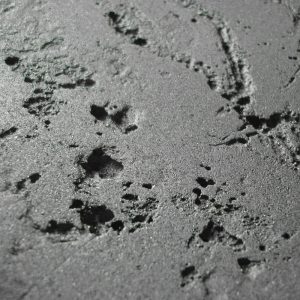
Intergranular:
This type of corrosion may occur next to a weld if the carbon content of the stainless steel is too high. When stainless steel is welded, the material next to the weld reaches a temperature of only 800° to 1500°F. At these temperatures, the chromium and carbon form chromium carbides. Chromium carbides deplete the chromium at the weld interface and sensitise the material, making it subject to corrosion.
If a weld interface is deficient, it cannot maintain the passive film. This area becomes anodic, while the rest of the material is cathodic. When the material is in water or moist air (the electrolyte), current will flow, resulting in corrosion (rusting) at the weld interface. By reducing the carbon content, we can prevent carbides from forming.
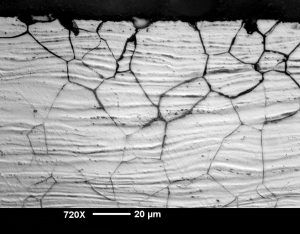
Chromium Carbides forming at the grain boundaries
Biological:
When a metallic surface is immersed in water, a biofilm will begin to form if there are any bacteria in the water. A biofilm is a microbial mass composed of aquatic bacteria, algae, or other microorganisms. The biofilm begins when organic material is absorbed onto the surface of the metal. The flow of water transports microbes to the surface, and the microorganisms attach and then grow, using nutrients from the water.
When the microorganisms grow, oxygen is excluded, which creates a place where the passive film may break down. With the breakdown of the passive film, the site becomes anodic with the likelihood of corrosion. Biofilm formation is most likely in spots where the flow of water is low, such as voids, crevices, and thread joints.
Microbiologically influenced corrosion (MIC) is defined as corrosion that is influenced by the presence and activities of microorganisms, including bacteria and fungi. Microorganisms located at the metal surface do not directly attack the metal or cause a unique form of corrosion. The by-products from the organisms promote several forms of corrosion, including pitting, crevice corrosion, and under-deposit corrosion.
Biological is often seen as a pitting attack. MIC is associated with the presence of a variety of organisms. Some can be easily observed such as barnacles, algae, mussels and clams while others cannot, such as microscopic bacteria. These microorganisms tend to attach to and grow on the surface of structural elements, resulting in the formation of a biological film or biofilm.
Typically, the products of a growing microbiological colony accelerate the corrosion process by either interacting with the corrosion products to prevent natural film-forming characteristics of the corrosion products that would inhibit further corrosion or by providing an additional reduction reaction that accelerates the corrosion process.
A variety of bacteria have been implicated in exacerbating corrosion of underground and subsea pipelines, and these fall into the broad classifications of aerobic and anaerobic bacteria. Obligate aerobic bacteria can only survive in the presence of oxygen, while obligate anaerobic bacteria can only survive in its absence. A third classification is facultative aerobic bacteria that prefer aerobic conditions but can live under anaerobic conditions. Common obligate anaerobic bacteria implicated in corrosion include sulfate-reducing bacteria (SRB) and metal-reducing bacteria.
Common obligate aerobic bacteria include metal-oxidising bacteria, while acid-producing bacteria are facultative aerobes. The most aggressive attack generally takes place in the presence of microbial communities that contain a variety of types of bacteria. In these communities, the bacteria act cooperatively to produce conditions favourable to the growth of each species. Obligate anaerobic bacteria can thrive in aerobic environments when they are present beneath biofilms/deposits in which aerobic bacteria consume the oxygen.
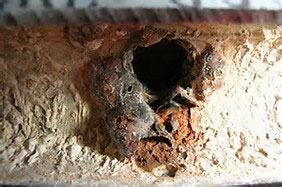
Watch out for Part 2 coming soon. We will be looking at Stress Corrosion Cracking and Corrosion Under Insulation.
Want to take your understanding of materials and corrosion to the next level? Why not become a certified American Petroleum Institute professional and take the API 571 exam. It’s no easy feat, but our training course will ensure you are fully prepared to take the exam. A full interactive e-learning course that you can study at home at your own pace.


